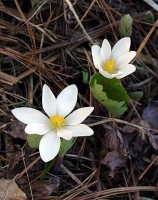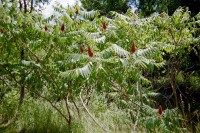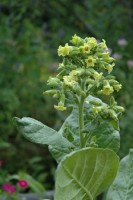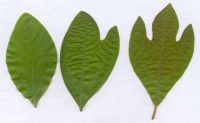Contributed by Brett PaddlesUpstream
The Following is a very brief introduction to Lenape plant use. I have chosen some of the “common” plants that you might see on a daily basis, in this area, and given their Lenape name and a very brief explanation of their use. This is not even scratching the surface of Native Medicines. That is a presentation all of its own, my intention is only to give you something to think of the next time you are walking or driving along and see one of these plants.
Native use of natural medicines is more than simply “grabbing some roots, leaves, or bark and cooking it or eating it,” the manor in which it is collected, the time of year, and the intent of the collector is equally as important and sacred as the plant itself, if not more so. Each plant, tree, herb, root, etc… was considered just as sacred and important as a member of the family, and was treated with respect, offerings and prayers offered before collecting, and nothing was wasted or collected “just to have.” Various medicines are collected, dried and stored for later use however fresh medicine is preferred.
The use of various plants and combinations of plants, barks, roots, and herbs vary from simple 1 and 2 medicine applications to 10 and 12 medicine compounds. Tonics were prepared by those skilled in herbal remedies for preparing for the seasonal changes in weather, for war, child ailments, and regular dietary supplements, each created with care and cultural protocol, following very closely to the traditional practices taught by the ancestors, each leaf, root, run of bark collected with care and consideration. While complex medicinal remedies were the art of Medicine People, in olden days all Lenape had basic herbal and medicinal knowledge.
*NOTE: This is in no way intended for medicinal use or recommend that anyone collect or use any of the medicines presented without proper training, education, or assistance. This is only for discussion purposes and is not intended as medical advice. While some simple plants and medicines will be discussed briefly, others are not a topic of discussion as they are ceremonial in nature and are best kept for just that.
Bloodroot (Pekon, Pukon)

Bloodroot
Getting its name from the red “blood-like” substance found in its root Pekon is used as a red, or vermilion dye in craftwork. Ceremonial face paintwas made from the root which was applied to the participants as well as the masks in the annual Big House Ceremony. Portions of the root leaves and “root bark” are also used to relieve stomach aches, cramps, vomiting, and warts. Today there is not an abundance of wild growing Bloodroot, however there are some very nice patches of it growing in Northeast PA and Northwest NJ.
Staghorn Sumac (Kelelenikanakw)

Staghorn Sumac
Used specifically by the Lenape as smoking mixture with tobacco, about 2/3 tobacco and 1/3 roasted sumac leaves. The Lenape name, Kelelenikanakw, actually signifies this with the meaning “mixture tree”. The Missionaries wrote that a Lenape camp could often be distinguished from others by the aroma of this smoking mixture used in their pipes. In addition to this the leaves, bark, roots, and berries are used for teas, dyes, and external applications to remedy such things as sore throat, toothache, and even arthritis. Today the Sumac is found growing along highways and along field edges.
Woodlands Tobacco (Kwshatay)

Woodlands Tobacco
A very sacred plant among all Native People. Well known for its ceremonial uses as well as its medicinal uses. While the Sumac and Tobacco mixture is specific to the Lenape, all Native People are documented as using tobacco either alone or mixed with other herbs, plants, or barks. Tobacco is used as an offering to the Spirits, as well as Creator and is smoked, in a pipe or leaf, sprinkled on a fire, or sprinkled on the Earth as an offering. In addition to its ceremonial use the leaves, flowers, and roots of the plant can be used to cure toothache, earache, indigestion, hunger pains, etc… Today there are probably not any wild tobacco growing, most is grown and collected from gardens.
Cattail (Ahpawi)

Cattail
Yes, the Cattail we all know and see on a regular basis! One of the most useful plants you will find. The mature leaves were woven to make mats, baskets, and covers for the wikwam (wigwam), the “fluff” makes a great tinder for making fire as well as stuffing for pillows and mattresses. The dried leaves made fine dolls much like the “corn husk dolls” of other tribes, however the Lenape did not use the corn husk dolls as a toy for children because of the spiritual significance of corn in Lenape Culture, so cattail leaves were a good substitute. The dried stalks make useful hand drills and arrow shafts. The leaves, young shoots, and root provide for “asparagus like” foods, antiseptics, ointments, flour, anti-itch poultice, and sweet syrup for use in puddings and breads. Today Cattail grows EVERYWHERE, yet few people remember its importance and resourcefulness as a wild plant.
Red Ceder (Pepxokwes)

Red Cedar
Used by many eastern tribes as an “incense” burned to purify oneself, ceremonial objects, and lands or homes. The twigs were useful in treatment for rheumatism. The wood was useful in outdoor fixtures because it weathered well, held up to moisture and repelled insects, thus the “Cedar Chest” for storing clothes and blankets. Other uses are “anti-itch,” and skin irritations. “Red Cedar” is not a “true cedar,” it is actually Juniper, and today grows everywhere.
Sweet Grass (Winkimakwsko)
![Sweetgrass [Image Source: Clark, George and Fletcher, James: “Farm Weeds” (1906)... Public Domain]](https://nanticokelenapemuseum.org/~/wp-content/uploads/2010/05/Sweetgrass-120x200.jpg)
Sweet Grass
Also called “Indian Perfume”, this grass was used as an insect and moth repellent and a form of incense burned in Ceremony to appease the Spirits. The smell is believed to have calming properties and often a braid or bundle would be hung above the bed. Tea could be made for coughs, a hair wash, and an eye wash. The strength of the strands served well for weaving and sewing. [Image Source: Clark, George and Fletcher, James: “Farm Weeds” (1906)… Public Domain]
Sassafrass(Winakw)

Sassafrass
Also called the “mitten tree” due to the 1,2, and 3 “finger” leaves found on the tree. The Lenape used the root of young trees and the bark of older trees for the “Spring Medicine”, as it thins the blood and helps to get the body ready for the hot humid weather. Sassafrass Tea was also made from the roots and bark and acted as a diuretic, young shoots were used to make Root Beer, until 1976 when it was banned by the FDA and listed as a carcinogen due to the “safrole” found in the oil of the roots and bark. While still used in moderation in ceremony and medicinal uses, it is not enjoyed as much as in historic times. The essential oil was also used as an antiseptic and pain reliever in tooth problems, the oil acted as a bug repellant, and bark, leaves, and shoots were often stored with clothes to keep insects away, also used as a fragrance in perfume. Dried and crushed leaves are used for seasonings, even today as the amount of safrole is extremely small. The wood mixed with the bark make an orange/yellow dye. Today Sassafrass grows everywhere, further North the trees are little more than a “shrub” and further South they are large full size trees





![Sweetgrass [Image Source: Clark, George and Fletcher, James: “Farm Weeds” (1906)... Public Domain]](https://nanticokelenapemuseum.org/~/wp-content/uploads/2010/05/Sweetgrass-120x200.jpg)

